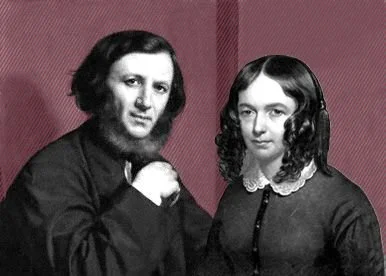Read: “Lady’s Maid,” a historical fiction romance about Elizabeth and Robert Browning
If you like Downton Abbey, stories of Victorian England, and real life romance, you’ll love this criminally under-read book, “Lady’s Maid”. This 1992 historical fiction novel delves into the uncommonly familiar relationship between the poetess Elizabeth Barrett Browning and her reallife lady’s maid, Elizabeth “Lily” Wilson. Author Margaret Forster, who writes meticulously researched historical fiction, explores the uneasy intimacy between mistress and servant during the Victorian Era in England.
Throughout the reign of Queen Victoria (1837-1901), there were rigid rules and boundaries between the classes and the stations within the classes. A Lady’s maid took charge of her employer’s entire wardrobe, styled her hair, and managed all of her accessories. She would pack for trips and accompany her mistress in all of her traveling. She would work from the crack of dawn often until midnight and was usually allowed one day off per month. What was unusual between Elizabeth and Lily was the friendship Elizabeth offered to Lily and the secrets shared between the two. Wilson’s only emotional support was her mistress.
Wilson was born in 1820 beginning as a scullery maid at age 13 and working her way up to a second parlor maid at age 16. She was lucky to secure a position as Elizabeth’s lady’s maid when she was in her early twenties.
Elizabeth Barrett, born in 1806, was the oldest of 12 children. She had two sisters and nine brothers. Her mother died when she was 22 years old and her father Edward ruled the Barrett household with an iron fist. He forbade all of his children to marry, threatening to fully disown and disinherit them if they chose to disobey. His upbringing led him to believe his wife and children were morally obliged to obey him in every sense of the word. Some historians hint of an incestuous relationship between Mr. Barrett and Elizabeth. He shared a common door from his bedroom into Elizabeth’s bedroom.
When Wilson arrived in 1844, Elizabeth was an invalid with a persistent cough confined to a dark and stifling hot room. She was a brilliant thinker and poet who battled depression through most of her adult life.
In the novel, Elizabeth tells Wilson she wishes to be thought of as her friend. That felt dangerous to Wilson as there was little room for mobility between the classes.
The courtship of Elizabeth and Robert Browning began when he dashed off a letter to Elizabeth on January 10, 1845 after reading some of her poems. In his letter, he tells Elizabeth he loves her. They met five months after Robert’s first letter and in just 20 months Robert and Elizabeth would write 574 letters to each other. All but one has survived. Even though Elizabeth looked so ill when they met that he thought she had an incurable disease, he passionately loved her.
Wilson was always on hand to keep Elizabeth’s romance a secret from Elizabeth’s father. Elizabeth knew her father would never change, and quietly married Robert at St. Marylebone Church on September 12, 1846. Wilson protected Elizabeth’s secret marriage to Robert, even standing as a witness.
All three of them secretly left for Italy. Although both Robert and Elizabeth made Wilson feel like a dear friend, Wilson was afraid going abroad meant she would become less indispensable to Elizabeth. She also knew it might mean never seeing her family again.
Elizabeth and Robert found a home in Florence, Italy (See our “Go” post to visit/learn about their real-life house, “Casa Guidi”) on the piano nobile of the 16th century Palazzo Guidi that they would share until Elizabeth’s death in 1861. Elizabeth named their flat Casa Guidi. It was here they would both write some of their most important works.
Elizabeth immediately became caught up with Florentine politics and fighting for Italian Unification. Wilson had a hard time adapting, realizing more and more she would never be anyone’s first concern.
Wilson was there for Elizabeth in every crisis, every heartbreak, and every triumph. But when Wilson’s life takes a turn, she realizes she has deluded herself into believing that she and Elizabeth share a special relationship, when really no matter any previous affection shared between the two, relationships were always defined by class.
No more spoilers. This book is an epic history lesson filled with shocking family dynamics, class distinctions, politics, love, poetry, loyalty, indifference, sacrifice, rigidity, fighting for independence, loneliness, hypocrisy, and survival during Victorian times.
This is an excellent read and a book that will make you think. It’s a book that will make you examine your own beliefs about class distinctions that are still in place today. It’s a book that will get under your skin.
*Note - If this book piques your interest, you might want to check out a fascinating biography of Elizabeth and Robert’s marriage written by Julia Markus called Dared and Done. Markus has been called by Pat Conroy (another favorite author of mine who sadly passed away a few years ago) “one of the most gifted novelists of her generation.”
